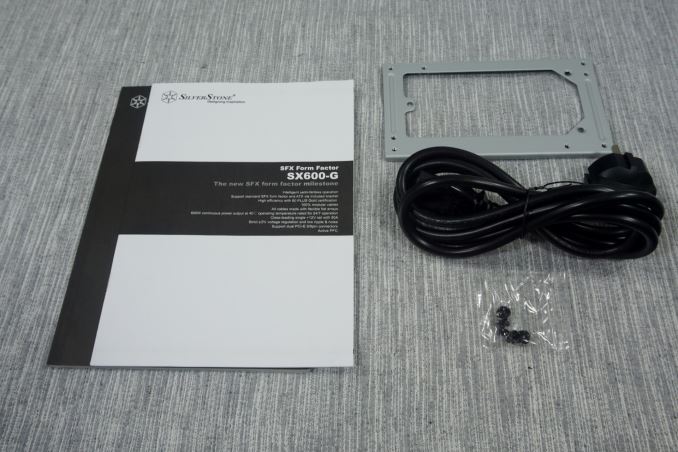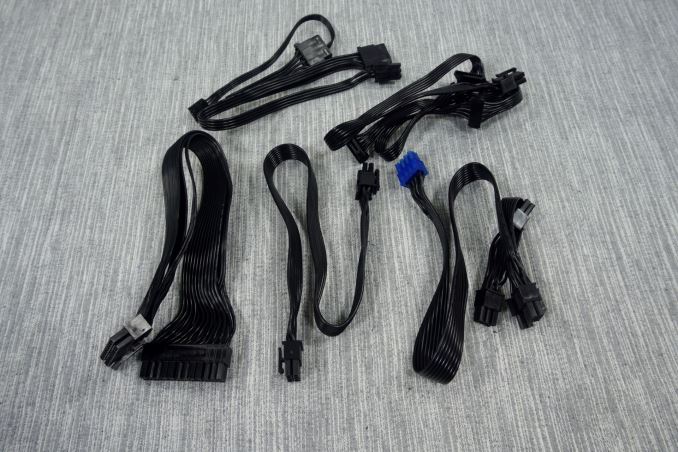The SilverStone SX600-G SFX PSU Review
by E. Fylladitakis on August 21, 2015 8:00 AM EST- Posted in
- PSUs
- Cases/Cooling/PSUs
- 80Plus Gold
- SilverStone
- SFX
- 600W
- Enhance

SilverStone offers a great variety of both cases and power supply units, but they are nonetheless primarily known for their numerous small form factor cases and non-standard designs. Designs such as these often require very careful consideration of the hardware that will be installed in them, or even special versions of hardware exclusively designed for such systems. We have reviewed a number of their cases in the past, but it is products like the Milo ML04 and ML05 that really stand out when it comes to offbeat, specialized form factors. Meanwhile given their unusual form factor, Silverstone also supplies products like their SFX PSUs and slim optical drives to fit such designs.
In fact Silverstone supplies a surprisingly large range of products for their small form factor designs, giving their cases quite a bit more flexibiltiy than one would normally expect. On the PSU side for example, the company currently offers five different SFX form factor PSUs, ranging from 300 to 600 Watts, suitable for driving everything from the true HTPC to portable gaming machines.
To that end, today we'll be looking at the most powerful of these SFX PSUs, the SX600-G. The tiny SFX PSU measures just 125mm × 63.5mm × 100mm, or a bit less than half the size of a standard ATX power supply. Yet in that space Silverstone has built a PSU capable of supplying 600 Watts with 80Plus Gold certification and modular cables as well, allowing it to power even the most power-demanding system that could fit in a case that requires such a power supply.
| Power specifications ( Rated @ 40 °C ) | |||||
| AC INPUT | 100 - 240 VAC, 50 - 60 Hz | ||||
| RAIL | +3.3V | +5V | +12V | +5Vsb | -12V |
| MAX OUTPUT | 20A | 15A | 50A | 2.5A | 0.3A |
| 90W | 600W | 12.5W | 3.6W | ||
| TOTAL | 600W | ||||
Packaging and Bundle
We received the SilverStone SX600-G SFX PSU in a relatively small cardboard box, yet large and sturdy enough for the small PSU. The artwork seems a bit excessive, combining abstract and geometric patterns along with a picture of the unit itself. The most basic features of the PSU can be read at the front side of the box and more details are printed on the back.
For the most part the SX600-G's included bundle is rather plain, with Silverstone shipping the necessary mounting screws, an AC power cable, and a manual. Unexpected however, SilverStone also provides one extra and rather interesting item alongside with the SX600-G SFX PSU: an SFX to ATX mounting adapter. Our best guess is that SilverStone is also looking to sell this PSU for use in small ATX cases, where space is similarly an issue. However, the very short cables supplied with the PSU are going to be an issue with that concept.
This is a fully modular design so every cable can be detached, including the 24-pin ATX cable. All of the cables are "flat", ribbon-like, including the thick 24-pin ATX cable, with SilverStone apparently aiming to cut down on cable slack and save as much space as possible in the process. Be warned that these cables are much shorter than those of a regular ATX PSU, with the ATX power cable being just 30 cm (11.8") long. Every cable is made by using black wires and black connectors, with the sole exception of the PSU-side connector of the PCI Express power cable, which is blue.
Overall the number of connectors is actually very low for a PSU with this high of a power output rating. This means that the SX600-G will typically operate with plenty of headroom, as it would be difficult to completely load down a 600W PSU off of only single high-power video card and CPU.
| SilverStone SX600-G | ||
| Connector type | Hardwired | Modular |
| ATX 24 Pin | - | 1 |
| EPS 4+4 Pin | - | 1 |
| EPS 8 Pin | - | - |
| PCI-E 6+2 Pin | - | 2 |
| PCI-E 8 Pin | - | - |
| SATA | - | 4 |
| Molex | - | 2 |
| Floppy | - | 1 |













20 Comments
View All Comments
meacupla - Friday, August 21, 2015 - link
From personal experience, the SATA cables they include aren't suitable in their own cases, at least not in RVZ01.Right angle SATA connectors are completely inferior compared to straight ones inside cramped cases, because the "T", that theconnector forms with its cables, gets in the way more often than not and causes a lot of stress onto the drive connector or the cables.
The right angle SATA connectors are so bad, in fact, that I am forced to use 4-pin molex to straight SATA cables, which adds further clutter inside an already cramped case.
edzieba - Friday, August 21, 2015 - link
The downside of straight connectors is that you now need to accommodate the Minimum Bend Radius behind the drive for the cable to make a 90° turn (extra wasted space), and you need to run DOUBLE the number of actual wires through the case (due to the lack of daisy-chaining).meacupla - Friday, August 21, 2015 - link
no you don't? There are daisy-chained straight SATA connectors. This was a pretty standard type of connector found on older PSUs, but for some reason, I haven't seen many, and by that I mean none, these days.This is the perfect solution, daisy chain straight connectors: http://cdn.overclock.net/a/a8/a8f3a740_2012-12-09_...
You see, the problem with right angle connectors, is that you need accommodate the minimum bend radius between the drives anyways, because these connectors aren't spaced to the typical drive spacing.
And also, I would like to stress that 'right angle' power connectors are the 'wrong angle' in RVZ01. The 2.5" drives are belly up. The "right" angle connectors protrude above the side panel.
Margalus - Friday, August 21, 2015 - link
both types of connectors suffer from the same problems with Minimum Bend Radius, just in different situations.as for daisy chaining straight connectors, I haven't seen one with several straight connectors, I don't see how that would even be possible. The one you show just shows a single connector at the end like typical straight connectors, not several daisy chained together like you can have with the 90° cables.
not saying 90° cables are better, or that straight cables are better. they both have their uses.
geniekid - Friday, August 21, 2015 - link
More SFX/SFX-L reviews!Flunk - Friday, August 21, 2015 - link
So in summation, if you want a 600W SFX power supply you have to buy this one.About the cables, Silverstone uses the same standard for all their modular cables and has for quite a while. They offer a wide range of replacement cables in different lengths and even single cables. Not only that if you buy a bunch of their power supplies you end up with a bunch of extra cables. That's a great reason to keep buying their products. The last 4 power supplies I've bought were Silverstone, mostly so I can mix and match cables with my existing collection if I need a longer/shorter one.
meacupla - Friday, August 21, 2015 - link
Actually, Athena Power has a bunch of SFX PSUs that are over 600W and they even have an 800W model.Silverstone is also going to release a 700W model of their SST-SX500-LG, although, strictly speaking, these "Long" models don't conform to SFX standards.
Personally, I don't see how or why you would want more than 500W, because I'm quite sure you would run into thermal issues with a CPU+GPU that would require that kind of power in a case these SFX PSUs are designed to go in.
BrokenCrayons - Friday, August 21, 2015 - link
First off, thanks for reviewing power supplies of lower wattage and it's great to see Anandtech taking a look at SFX PSUs in particular. Not all of us are interested in 1000 watt supplies so the variety is great.But I did notice..."The OEM behind the *very* densely packed design you see below is Enhance. Enhance is not a *very* common manufacturer for *very* high output PSUs..." this review contained a lot of "very" and "relatively" which hurt readability somewhat.
Ryan Smith - Friday, August 21, 2015 - link
Yeah, we did go a bit overboard there. Thanks for pointing it out.ruthan - Friday, August 21, 2015 - link
2 year ago i looked for SFX PSU and only choice was Seasonic 300W and even with 30W power outcome was noise. So i moved into expensive picoPSU and after that for second very small machine i selected board with laptop like external adapter connector and adapter bundled with Akasa Euler S.Usually if you case about size, you want to have machine near of you and it means machine should be quiet.. So for smaller power consumation (<200W) machine there are better laptop like solution and for bigger machines is still ATX PSU needed.. or maybe there are some niche never where reviewed extendar passively cooler 300W boxes.. - but there are not small, so..